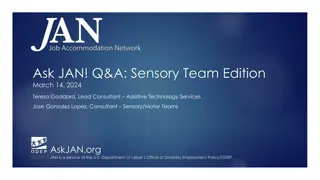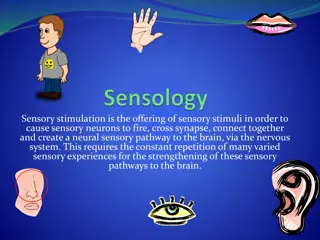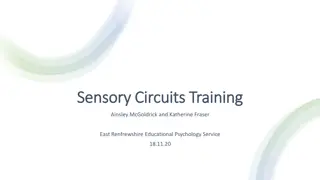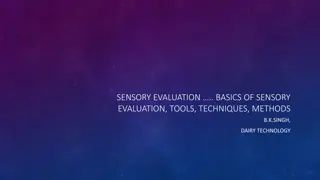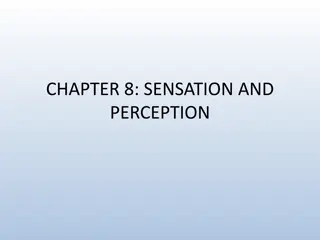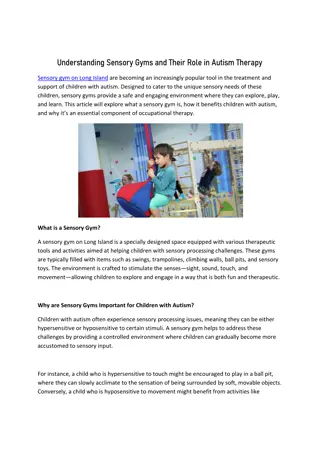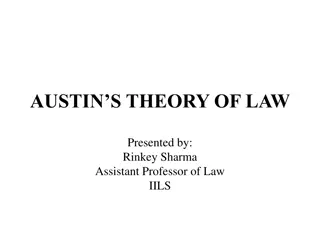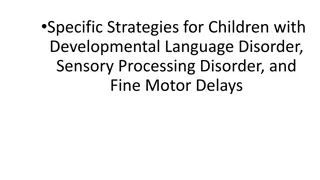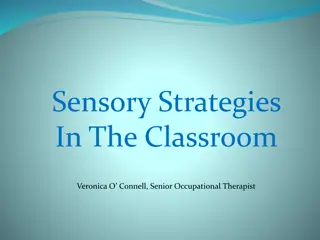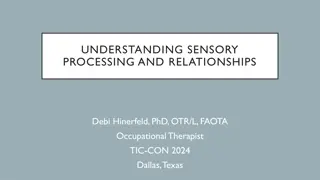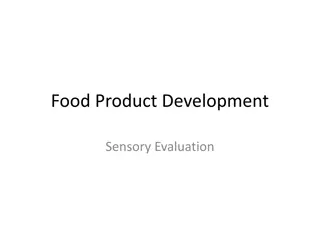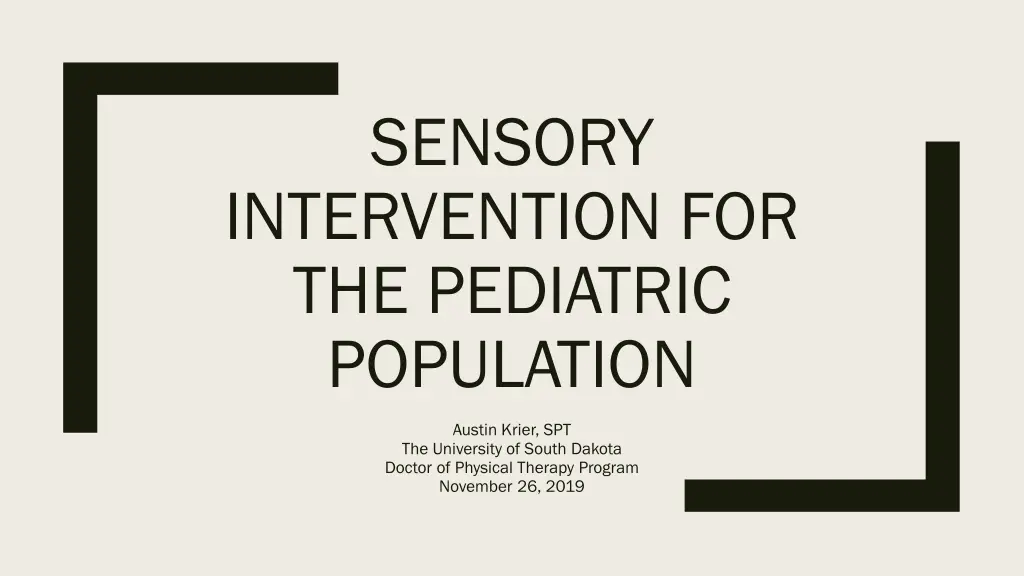
Pediatric Sensory Intervention Strategies
Explore sensory behaviors in children, recognize common populations expressing these behaviors, and discover effective strategies for sensory-based interventions. Gain confidence in seeking resources to enhance understanding.
Download Presentation

Please find below an Image/Link to download the presentation.
The content on the website is provided AS IS for your information and personal use only. It may not be sold, licensed, or shared on other websites without obtaining consent from the author. If you encounter any issues during the download, it is possible that the publisher has removed the file from their server.
You are allowed to download the files provided on this website for personal or commercial use, subject to the condition that they are used lawfully. All files are the property of their respective owners.
The content on the website is provided AS IS for your information and personal use only. It may not be sold, licensed, or shared on other websites without obtaining consent from the author.
E N D
Presentation Transcript
SENSORY INTERVENTION FOR THE PEDIATRIC POPULATION Austin Krier, SPT The University of South Dakota Doctor of Physical Therapy Program November 26, 2019
Objectives Recognize sensory behaviors exhibited by a child Understand which populations commonly express sensory behaviors Identify misunderstandings in the literature Develop confidence in seeking resources to further understanding
Observed Sensory Behaviors1 Hyperresponsive Covering ears Covering ears, negative reaction to normal sounds Avoiding sunlight Avoiding sunlight through window Pain reaction to every day activity Pain reaction to every day activity such as combing hair or brushing teeth Hyperresponsive behavior associated with familiar stimuli (Kirby)
Observed Sensory Behaviors1 Sensory Seeking and Repetitive/Stereotypic behaviors Excessive gross motor movements to increase proprioceptive input Excessive gross motor movements to increase proprioceptive input: Jumping on stairs, bouncing on large ball, throwing body into furniture or onto floor, rough housing, swinging with head back(Kirby) Auditory Auditory: listening to loud music or television, leaning close to video screen Visual/Tactile perseveration on objects Visual/Tactile perseveration on objects: rubbing face with objects, rolling on carpet floor, putting objects into mouth
Observed Sensory Behaviors1 Repetitive/Stereotypic Behavior Proprioception Proprioception: rocking back and forth, flapping hands Auditory/Visual Auditory/Visual: watching/listening to video clip repetitively, lining up toys, repeating phrases, vocalizing/humming.
Populations Autism Spectrum Disorder (ASD)1 Developmental Coordination Disorder2 Attention Deficit Hyperactivity Disorder3 Obsessive Compulsive Disorder4 Down Syndrome5 Anxiety Disorder6 Why do sensory processing issues matter?
Confusion in the Literature Sensory-Based Intervention These ineffective strategies (to improve ASD sensory-based impairments) include (1) weighted vests and other compression garments used to provide proprioceptive input and calming to increase attention, concentration, and focus; (2) brushing and sensory diets to increase tolerance to tactile input, increase focus, and improve organization; (3) fidget and fiddle toys to help sustain attention and concentration; and (4) Auditory Integration and Therapeutic Listening programs. 7 Sensory Integration Interventions Sensory Integration Intervention (Specific to Ayres Sensory Integration Intervention Protocol)
American Academy of Pediatrics Policy Statement Sensory Integration Therapies for Children with Developmental and Behavioral Disorders6 (2012) 1. At this time, pediatricians should not use sensory processing disorder as a diagnosis. 2. Pediatricians should communicate with families on the limited data for the use of sensory-based therapies for the developmental and behavior problems. 3. If the pediatrician is managing a child whose therapist is using sensory-based therapies, it is important to teach the family how to determine if the therapy is effective through development of goals with the therapist. 4. Pediatricians should inform families that occupational therapy is a limited resource based on the number of sessions allowed through the school/insurance, thus a team approach to treatment, including the family will be the most effective
A Systematic Review of Ayres Sensory Integration Intervention for Children with Autism8 Ayres Sensory Integration Intervention (ASI): Individualized intervention designed to address the specific underlying sensory-motor issues that may be affecting children s performance during daily routines and activities, including participation within the classroom and in other contexts of the school Requires: Clinical Reasoning to ensure activities address specific difficulties Difficulties are linked to child s functioning in daily life Takes place within a context of play, increasing child participation Focus on participation-oriented outcomes
A Systematic Review of Ayres Sensory Integration Intervention for Children with Autism8 Lack of consensus regarding evidence base Existing studies in the literature: Not consistent with principles originally described by Ayres Use of isolated sensory stimuli as the primary mode of intervention, rather than adhering to principles of ASI Passively applied to the child, lack of individualization Ignore the therapeutic alliance between therapist and child Do not present replicable description of the intervention Only 3 studies ultimately met inclusion criteria Results of these studies support the evidence-based use of ASI for 4-12 year-old children with Autism to improve participation in daily life activities, routines,
Given the evidence, what does this Given the evidence, what does this mean? mean?
Treat the Patient Treat the Patient (Specifically, the Impairment) (Specifically, the Impairment) Not the Diagnosis Not the Diagnosis
Sensory Interventions Where to start? Guided Functional Behaviour Assessment9 Autism Hub and Reading Centre https://ahrc.eq.edu.au/services/fba-tool The Collaborative for Leadership in Ayres Sensory Integration (CLASI) Certification10 https://www.cl-asi.org/intro
Conclusion The Evidence is Mixed (relatively)
Conclusion The Evidence is Mixed (relatively) Your treatment depends on the individual patient, the impairment needs, and the end goal.
References 1. Kirby AV, Boyd BA, Williams K, Faldowski RA, Baranek GT. Sensory and receptive behaviors among children with autism spectrum disorder at home. Autism. 2017;21(2): 142 154. doi:10.1177/1362361316632710. 2. Allen S, Casey J. Developmental coordination disorders and sensory processing and integration: Incidence, associations and co-morbidities. BJOT. 2017;80(9) 549 557. 3. Lane SJ, Reynolds S. Sensory over-responsivity as an added dimension in ADHD. Front Integr Neurosci. 2019;13(40): 1-12. doi: 10.3389/fnint.2019.00040 4. Van Huelle CA, Esbensen K, Goldsmith HH. Co-occurrence of sensory overresponsivity with obsessive- compulsive symptoms in childhood and early adolescence. J Dev Behav Pediatr. 2019;40: 377 382. 5. Abd El-Maksoud GM, Abd-Elmonem AM, Rezk-Allah SS. IJTRR. 2016; 5:4 Idoi: 10.5455/ijtrr.000000142 6. Zimmer M, Desch L. Sensory integration therapies for children with developmental and behavioral disorder. Pediatrics. 2012; Print, 0031-4005; Online, 1098-4275. doi:10.1542/peds.2012-0876 7. Palisano RJ, Orlin MN, Schreiber J. Campbell s Physical Therapy for Children. 5thEdition. Elsevier. St. Louis, MO, 2017. 8. Schoen SA, Lane SJ, Maillous Z, May-Benson T, Parham D, Roley SS, Schaaf RC. A systematic review of Ayres sensory integration intervention for Children with Autism. Autism Research. 2019; 12, 6-19. 9. Autism Hub and Reading Centre. Guided Functional Behaviour Assessment Tool. https://ahrc.eq.edu.au/services/fba-tool 10. The Collaborative for Leadership in Ayres Sensory Integration. https://www.cl-asi.org/intro


